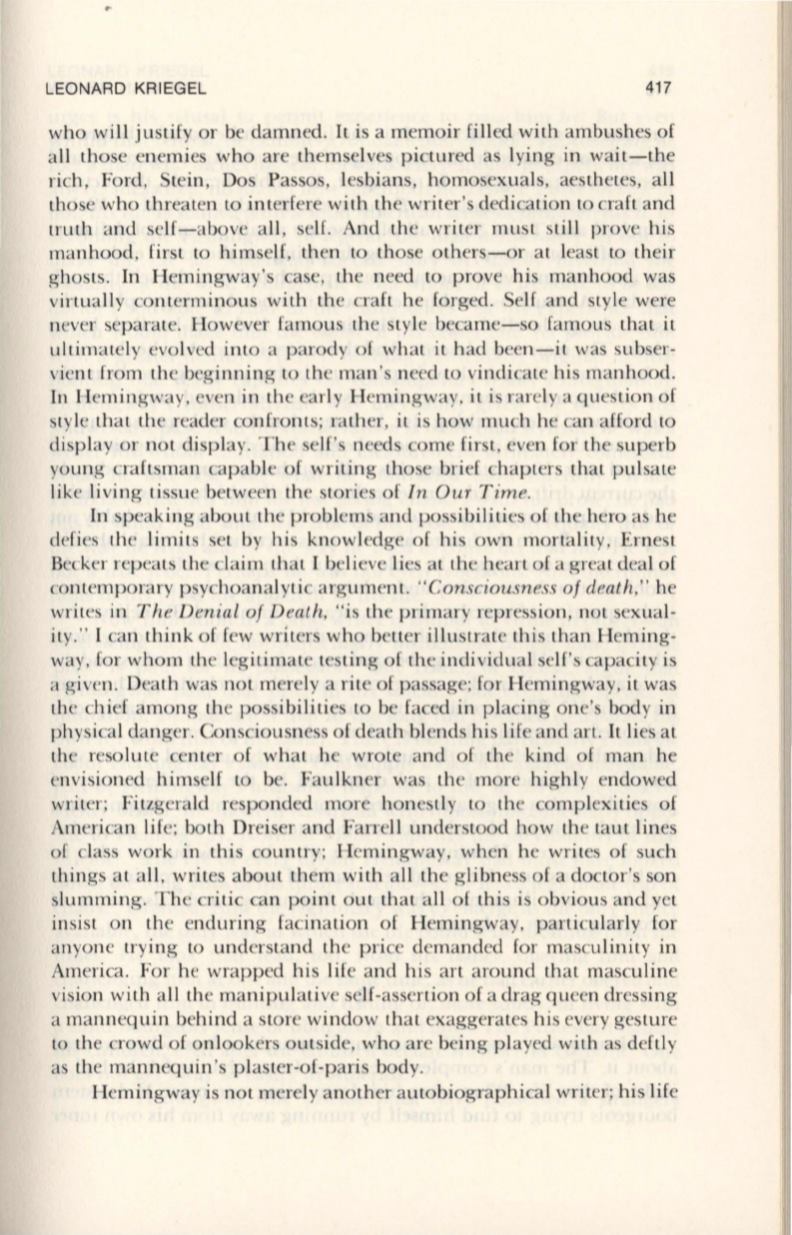
LEONARD KRIEGEL
417
who will justify or be damned .
It
is a memoir fill ed with ambushes of
all those enemi es who a re themselves pictured as lying in wait-the
ri ch , Fo rd , Stein , Dos Passos, lesbians, homosexuals, aes thetes, all
tho e who threa ten to interfere with the writer's dedi cati on to craft and
truth and self-above a ll , self. And th e writer must still prove hi s
manhood , first to himself, then to those o thers-or a t least to their
ghos ts. In Hemingway's case, th e need to prove hi s manhood was
virtua ll y conterminous with the craft he fo rged. Self and tyle were
never sepa ra te. However famous the style became- so famous tha t it
ultima tely evo lved into a parody o f what it had been-it was subser–
vi ent from the beginning to the man 's need to vindi ca te hi s manhood .
In Hemingway, even in the a rl y Hemingway, it is rarely a ques tion of
style tha t the reader confronts; ra ther, it is how much he can afford to
di splay or no t display. T he self's needs come first, even for the superb
young craftsman capabl e of writing those bri ef chapters tha t pulsate
like living ti ss ue between the stori es of
In
O U f
Time.
In speaking about the problems and poss ibiliti es o f the hero as he
defies the limits set by hi know ledge o f his own mortality, Ernes t
Becker repea ts the cl aim tha t I beli eve li es a t the hea rt o f a grea t dea l o f
contempo ra ry psychoanalyti c a rgument.
"Consciousness of death,"
he
writes in
The Den ial of Death,
" i the prima ry repress ion , not sexual–
ity." I can think o f few writers who better illustrate thi s than Heming–
way, for whom the leg itima te tes ting o f the indi vidual self's capacity is
a given. Dea th was no t merely a rite of passage; fo r Hemingway, it was
the chief among the pos ibilities to be faced in placing one' body in
ph ys ica l danger. Consciousn ess o f dea th bl ends hi s life and art.
It
lies a t
the reso lute center of wha t he wrote and of the kind o f man he
envisioned himse lf to be. Faulkner was the more highl y endowed
writer; Fitzgerald responded more honestl y to the compl exities o f
Ameri can life; both Dreiser and Farrell understood how the taut lines
of class work in thi s country; Hemingway, when he writes of such
things a t a ll , writes abo ut them with all th e glibness o f a doctor's son
slumming. T he critic can point out tha t all of this is obvious and yet
insist on the enduring facina tion o f Hemingway, pa rti cul a rl y fo r
anyone trying to under tand the price demanded for ma culinity in
America. For he wrapped hi s life and hi s art a round tha t masculine
vi sion with a ll the manipul a ti ve self-asserti on of a drag queen dressing
a mannequin behind a store window tha t exaggera tes hi s every ges ture
to the crowd o f onlookers outside, who are being pl ayed with as deftl y
a the mannequin 's plas ter-o f-pa ri s body.
Hemingway is no t merely ano ther autobiographica l writer; hi s life


